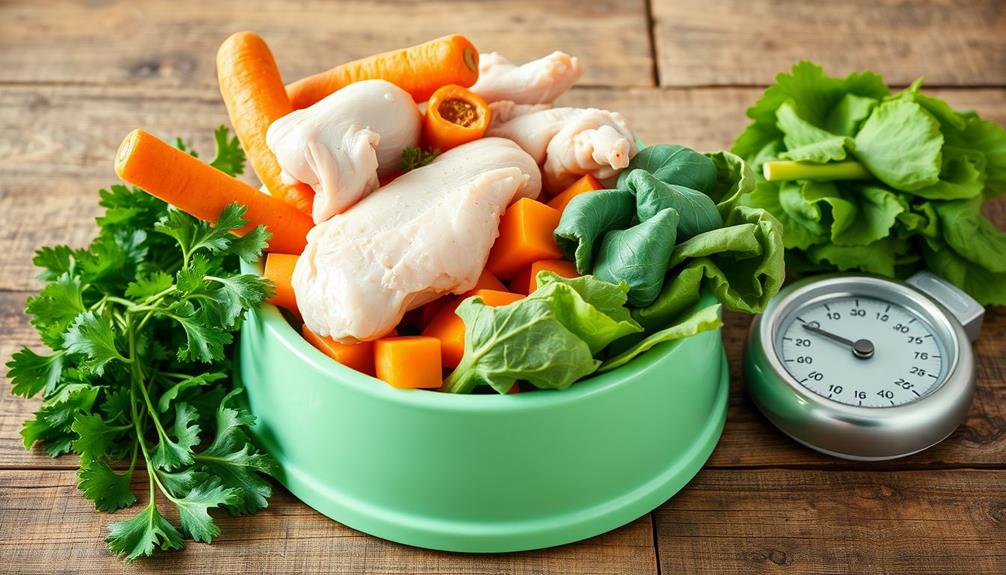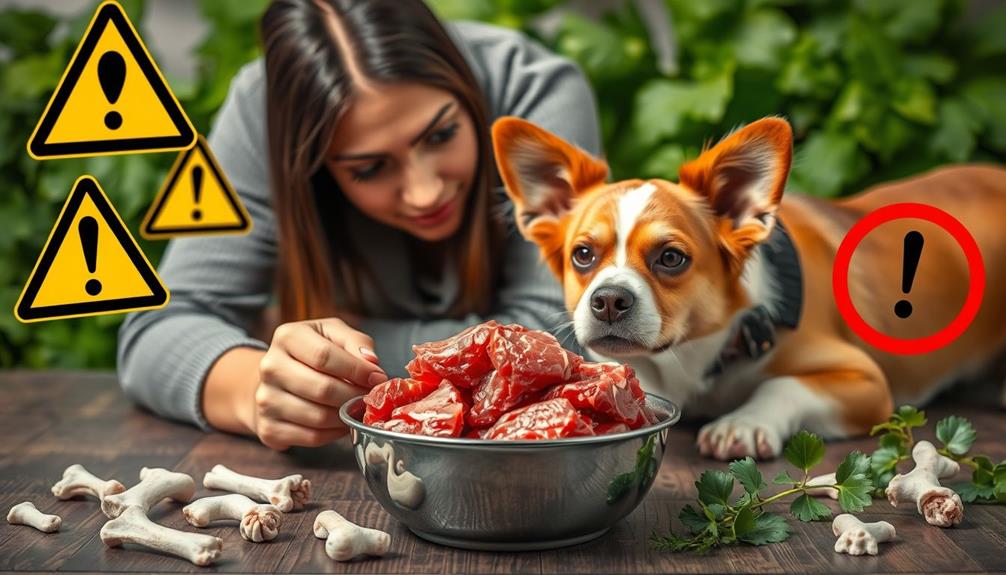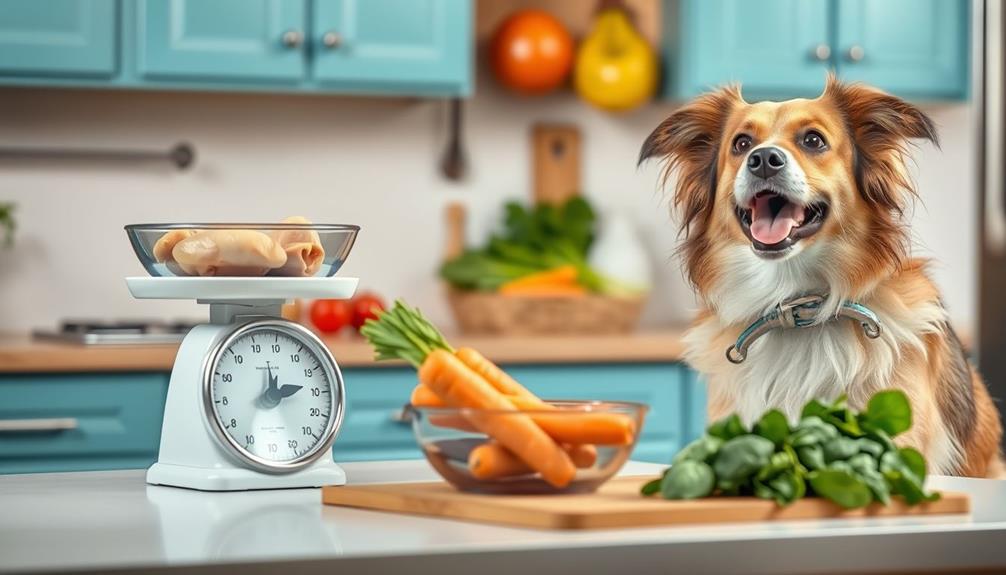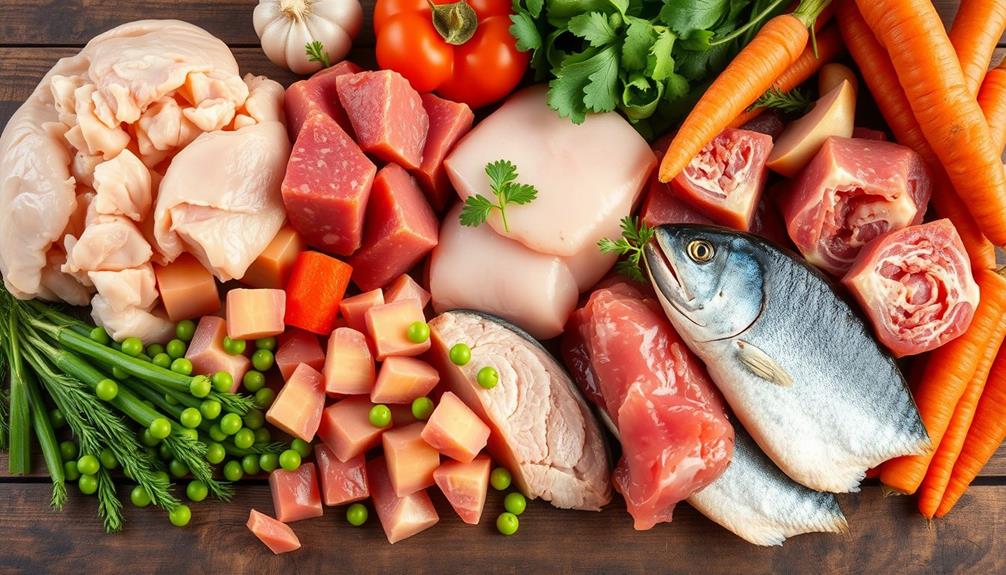To calculate how much raw food to feed your dog, start by determining their ideal body weight. Generally, you should provide about 2% to 3% of their body weight in raw food daily. For smaller dogs under 5 lbs, aim for 5-6%. Adjust the amount based on their activity level—active dogs may need about 3%. Split their daily portion into two meals to mimic natural feeding behavior. Regularly check your dog's weight and health to verify they're getting the right amount. There's a lot more to take into account, so keep going to discover additional tips! When planning a raw food diet for dogs, it’s important to consider their individual metabolism, age, and any health conditions they may have. It’s also crucial to provide a variety of protein sources, including beef, chicken, and fish, as well as fruits and vegetables. Consulting with a veterinarian or a pet nutritionist can help ensure that your dog’s raw food diet meets all of their nutritional needs. Always monitor your dog’s digestion, energy levels, and coat condition to gauge the success of the raw food diet for dogs.
Key Takeaways
- Feed adult dogs 2% to 3% of their ideal body weight in raw food daily, adjusting for activity level.
- For smaller dogs (up to 5 lbs), provide 5-6% of their body weight in raw food.
- Active dogs require approximately 3% of their ideal body weight, while sedentary dogs need 2-2.5%.
- Transition to a raw diet gradually over 7-10 days to minimize digestive upset.
- Use a raw food calculator to determine the appropriate food amount based on individual factors like age and health.
Benefits of a Raw Diet
Feeding your dog a raw diet can lead to a range of impressive benefits that enhance their overall health. One of the most notable benefits of a raw diet is improved nutrient absorption, which often results in a shinier coat and healthier skin. You might notice your dog experiencing fewer allergies, contributing to their overall comfort and well-being.
Additionally, providing a balanced raw diet can also support your dog's immune system, leading to a healthier and longer life proper diet includes fresh fruits.
Additionally, a raw diet can greatly boost your dog's energy levels and liveliness, making them more active and playful. When dogs chew on raw food, they also enjoy better dental health, as this practice helps reduce plaque and tartar buildup. This means not only a happier dog but a fresher breath too!
Improved digestion is another key advantage of a raw diet. You'll likely see smaller, more efficient stools, indicating that your dog is utilizing nutrients more effectively.
Even if you incorporate just 25% raw food into your dog's meals, you can experience these benefits of a raw diet. Overall, shifting to a raw diet can transform your dog's health in multiple ways, making it a worthwhile consideration for any pet owner.
Portion Guidelines and Calculations
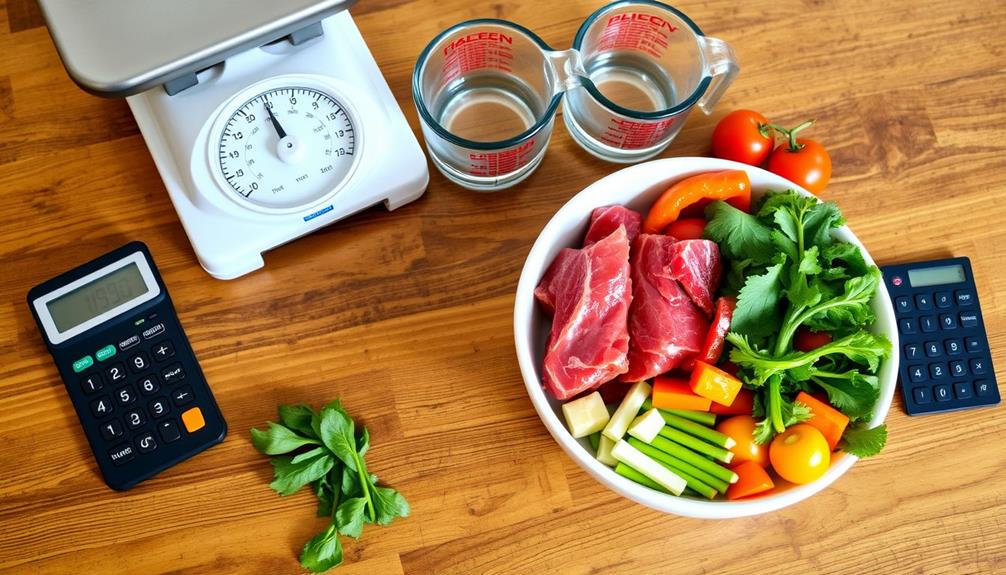
When feeding your dog a raw diet, it's essential to know the daily portion recommendations based on their weight.
Generally, you'll want to provide 2% to 3% of their body weight in food, but don't forget to adjust for their activity level. For instance, active dogs may require a bit more, while less active ones might need less.
Keeping an eye on your dog's weight will help you make necessary changes to their portions over time.
Additionally, incorporating healthy dog snacks can provide variety and enhance their overall nutrition.
Daily Portion Recommendations
Determining the right amount of raw food for your dog is essential for their health and well-being. For adult dogs, you'll want to feed them 2% to 3% of their body weight in daily portions. This can vary based on their activity level and overall health. Smaller dogs, particularly those weighing up to 5 lbs, may require a higher percentage—5-6% of their body weight.
Here's a quick reference table to help you calculate your dog's daily portion:
| Dog Weight (lbs) | Daily Portion (lbs) | Daily Portion (oz) |
|---|---|---|
| 5 | 0.25 – 0.30 | 4 – 5 |
| 25 | 0.5 | 8 |
| 50 | 1.0 | 16 |
| 75 | 1.5 | 24 |
| 100 | 2.0 | 32 |
It's best to divide this daily portion into two meals to mimic natural feeding patterns. Always monitor your dog's weight and health closely, as adjustments may be necessary, especially for active or underweight dogs. Use a raw food calculator for precision!
Adjusting for Activity Level
Adjusting your dog's raw food intake based on their activity level is vital for guaranteeing they receive the right nutrition. For active dogs, you should aim to feed your dog about 3% of their ideal body weight per day.
If your adult dog is at an ideal weight, feeding them 2-2.5% will help maintain peak health. Smaller dogs, particularly those weighing up to 5 lbs, need a higher percentage—5-6% of their body weight daily.
It's also beneficial to take into account incorporating natural remedies alongside conventional nutrition to support your dog's overall health.
To manage energy levels and digestion better, it's advisable to split their daily portion into two meals. Regularly monitoring your dog's weight is important, especially for more active dogs, to make necessary adjustments to their food intake.
This guarantees they stay healthy and energetic.
Starting Your Dog on Raw Food
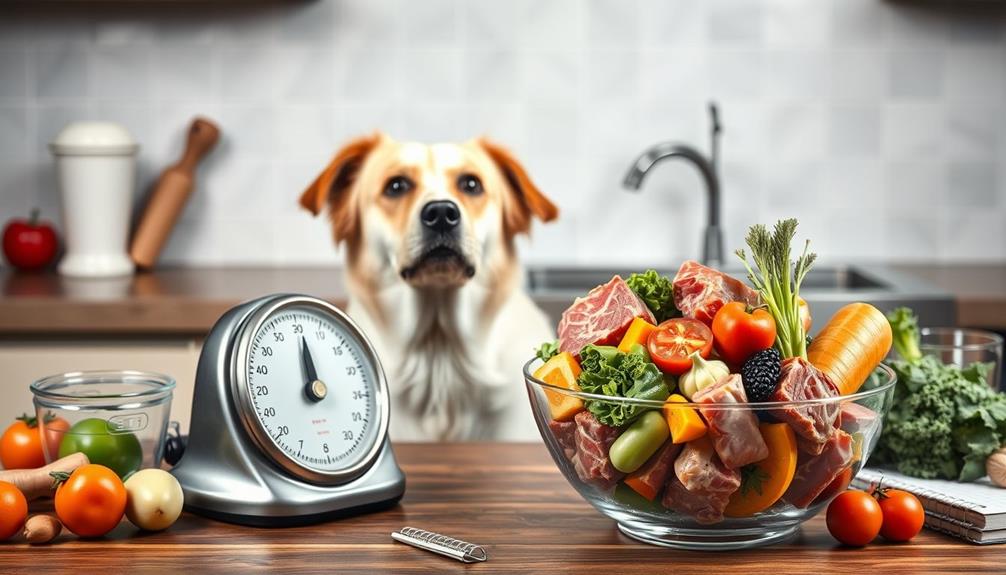
When starting your dog on raw food, it's essential to shift smoothly over 7-10 days to prevent any digestive upset.
During this shift, monitor for any gastrointestinal issues that might arise, as these can be common when changing diets.
Additionally, make sure that the raw food diet is balanced and provides all necessary nutrients, similar to how a juice diet can impact overall health if not managed properly nutritional benefits of juices.
Keep a close eye on your dog's health and adjust portion sizes based on their weight and activity level.
This careful approach guarantees your dog gets the right nutrition while minimizing any potential issues.
Transitioning Dogs Smoothly
Shifting your dog to a raw food diet can be a smooth process with the right approach. Start by introducing small amounts of raw food alongside their current diet to minimize any digestive upset.
It's also important to take into account your dog's unique nutritional needs, much like how one would assess personal savings goals in a financial plan.
Here's how to change dogs smoothly:
- Mix it up: Gradually blend raw food with their regular meals, allowing your dog's digestive system to adapt.
- Monitor weight: Expect some weight loss initially, usually due to water weight. Make sure it doesn't exceed 1-2% of their body weight per week.
- Use a raw feeding calculator: This tool will help you determine the right amount of food to introduce based on your dog's weight and dietary needs.
Always keep a close eye on your dog's energy levels and overall health during this change.
If you notice any issues, adjust the food intake as necessary. Collaborating with a veterinarian is essential to guarantee the change is safe and tailored to your dog's specific requirements.
Monitoring Health Changes
Monitoring your dog's health changes during the change to a raw food diet is essential for ensuring their well-being. As you adjust, keep an eye on their body weight and food intake, as initial weight loss is common. This should ideally remain within 1-2% of their body weight per week.
Pay attention to signs of digestive upset, like diarrhea or vomiting, which may indicate that you need to introduce raw food gradually. Regularly assess your dog's energy levels, coat condition, and overall health—these improvements can signal a successful adjustment to the new diet.
To help you track these changes, consider using the table below:
| Health Aspect | What to Monitor | Action Needed |
|---|---|---|
| Body Weight | Weekly weight checks | Consult a vet if weight loss exceeds 2% |
| Food Intake | Amount of food consumed daily | Adjust portions accordingly |
| General Health | Energy, coat, and health | Consult a vet if changes are concerning |
A consultation with a veterinarian is recommended to tailor the raw diet to your dog's specific needs and to address any health changes observed during the change.
Adjusting Portion Sizes
Adjusting portion sizes is essential as you start your dog on a raw food diet. To guarantee your pup gets the right amount of food, aim to feed 2% to 3% of their body weight daily. Understanding the importance of proper nutrition can also enhance your dog's overall health and well-being, similar to how wellness retreats for solo travelers promote holistic approaches to personal growth.
Here's how you can fine-tune their portions:
- Calculate Their Weight: Use your dog's weight to determine the daily raw dog food requirement. For instance, a 25-pound dog should get about 0.5 pounds (8 ounces) of raw food daily.
- Monitor Activity Level: Adjust the amount of food based on your dog's activity level. More active dogs might need closer to 3%, while less active ones may require only 2%.
- Observe Weight Changes: Keep an eye on your dog's weight during the shift. A weekly weight loss of 1-2% is acceptable, confirming they're on track for their proper weight.
As you introduce raw food, start small and gradually increase the amount while observing their reaction.
Using a raw feeding calculator can help you personalize portion sizes based on your dog's weight and dietary needs, ensuring a smooth shift to a superior diet.
Quality of Raw Food Ingredients
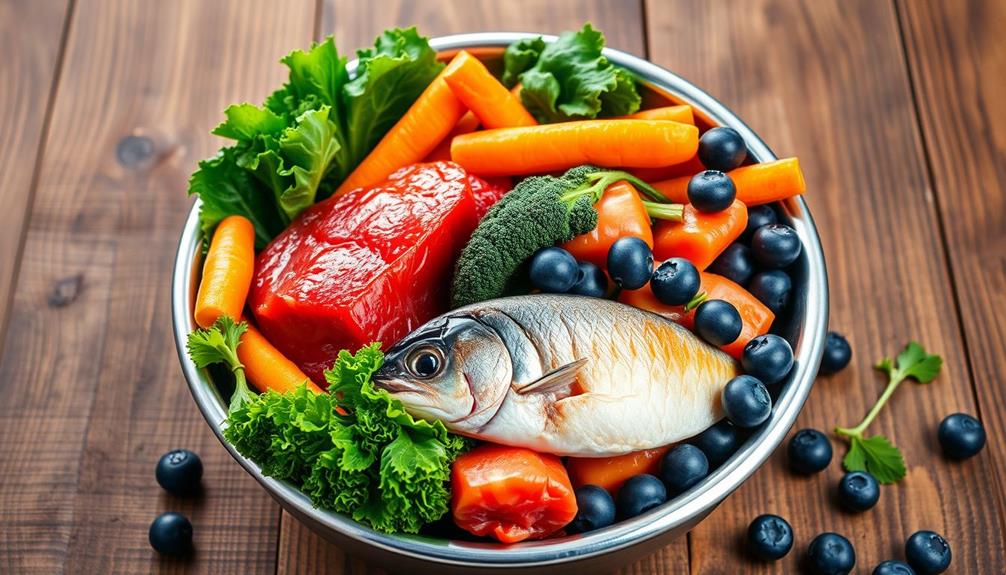
When choosing raw food for your dog, ingredient quality plays a significant role in their overall health and well-being. Developmental milestones in pets, like humans, can be influenced by their diet, so you should look for a balanced mix of muscle meat, organ meat, and finely ground bone to guarantee your pet gets a complete and nutritious meal at every stage of life.
Sourcing ingredients locally is essential; you want options that are hormone-free, antibiotic-free, and devoid of additives or preservatives. These factors greatly impact the nutritional value of the meals you provide. Prioritizing quality in raw food helps you maintain your dog's health while also assuring their meals are safe to consume.
Transparency in a company's practices is important. It allows you to make informed decisions about the raw food you choose. When brands openly share their ingredient sourcing, it enhances your trust in their products.
Additionally, quality control measures during production are crucial for maintaining safety and consistency. Proper preparation methods directly affect nutrient retention and palatability for your dog. By focusing on high-quality ingredients, you not only support your dog's health but also contribute to their overall happiness and energy levels.
Factors Influencing Food Amount
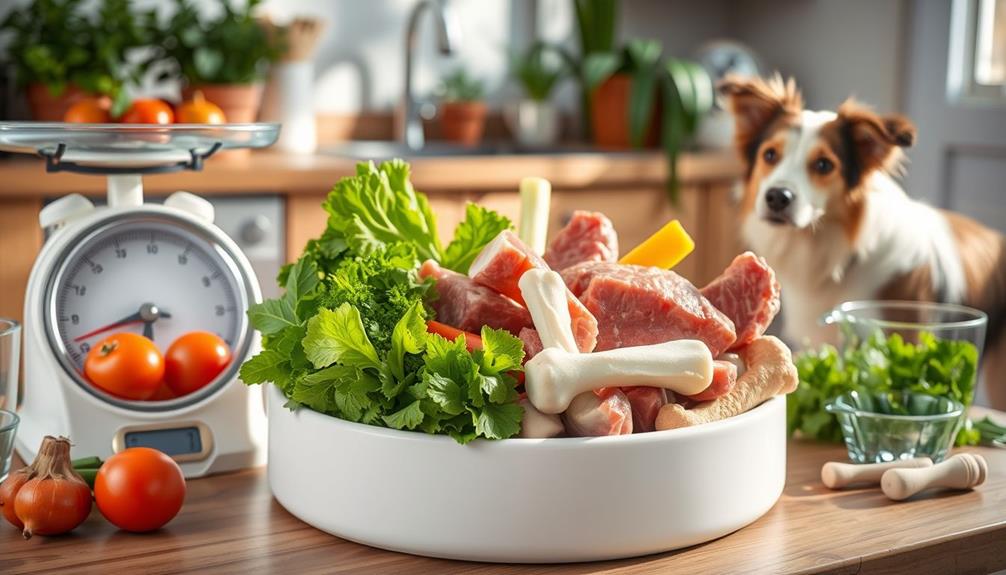
Understanding how various factors influence your dog's food amount is vital for maintaining ideal health. When feeding your dog, you'll want to take into account several key elements that impact their dietary needs:
Regularly evaluating your dog's health and adjusting their diet accordingly is also important, as certain health conditions can affect nutritional requirements, similar to how financial considerations for elderly care require careful planning.
- Age: Puppies and senior dogs have different nutritional requirements that can affect their food intake.
- Activity Level: Active dogs often require more food than their less active counterparts. You might need to feed up to 3% of their ideal body weight in raw food daily for high-energy dogs, while more sedentary ones may only need 2-2.5%.
- Breed Size: Smaller breeds typically need a higher percentage of their body weight in food. For instance, dogs weighing under 5 lbs might require up to 6%.
Regularly monitoring your dog's weight and body condition is essential for adjusting their food intake.
Feeding Guidelines for Adults
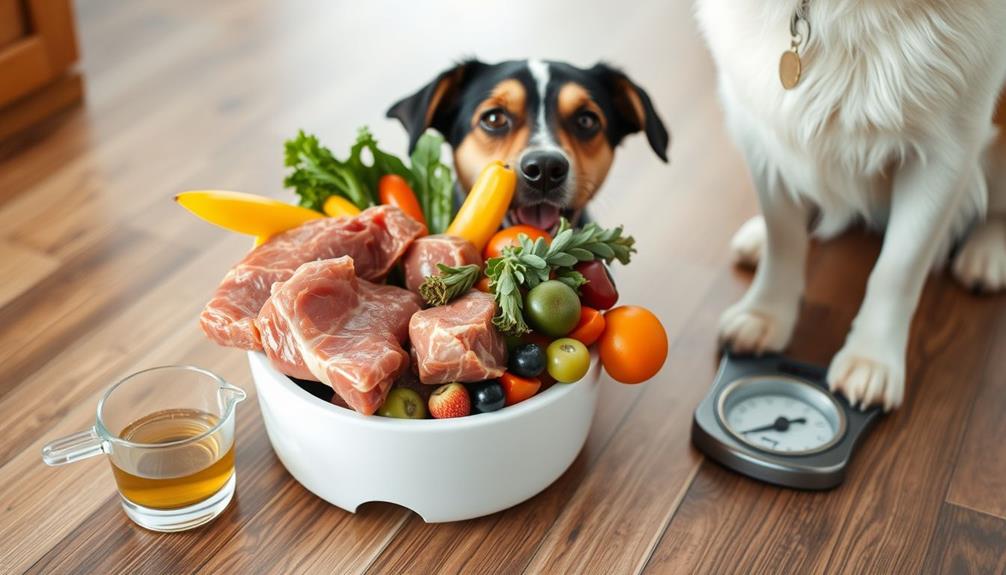
Feeding adult dogs requires careful consideration of their ideal body weight and activity level to guarantee they receive the right amount of raw food. Generally, adult dogs need about 2% to 3% of their ideal body weight in raw food daily. For instance, if your dog weighs 50 lbs, you'd feed them approximately 1 to 1.5 lbs of raw food each day.
Incorporating a variety of ingredients can enhance their diet, as this can provide vital nutrients, similar to how herbalism utilizes diverse plant properties for holistic health master plant properties. It's important to divide this daily portion into two meals, as this mimics natural feeding patterns and supports better digestion.
Keep in mind that smaller dog breeds tend to require a higher percentage of their body weight in food compared to larger breeds due to their faster metabolism.
Regularly monitoring your dog's weight is significant. Adjust their food intake as needed to maintain ideal health and prevent obesity. If you notice your dog gaining or losing weight unexpectedly, reassess the amount of food you're providing and make necessary adjustments.
Puppy Feeding Recommendations
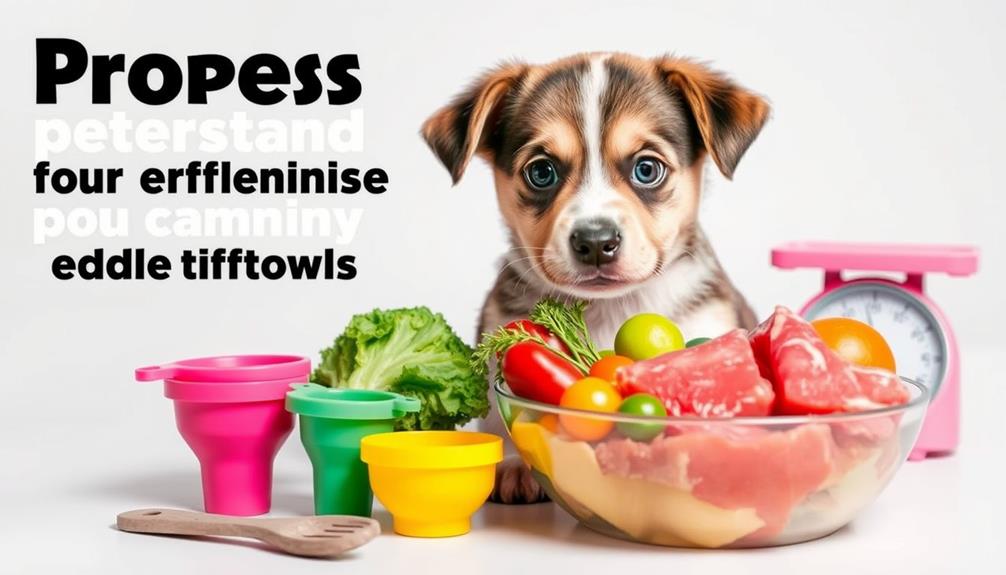
Puppies need around 5-10% of their current body weight in raw food daily to support their rapid growth and high energy levels. When you're figuring out how much to feed a puppy, consider these key points:
1. Age Matters: For puppies aged 5-8 weeks, you should feed three small meals per day. This helps guarantee they get adequate nutrition and aids digestion.
Engaging in interactive play with toys can also help develop their motor skills and socialization during this vital stage of growth, similar to how best educational construction toys for toddlers promote fine motor skills.
2. Adjust as They Grow: By the time your puppy reaches six months, the amount generally decreases to around 5% of their body weight as they approach adult size.
3. Change Timing: Aim to change your puppy to adult food around 12 months old. This will help maintain a balanced diet suitable for their mature energy needs.
Utilizing a puppy food calculator can further assist you in determining the daily feed volume based on your puppy's weight and age.
Transitioning to a Raw Diet
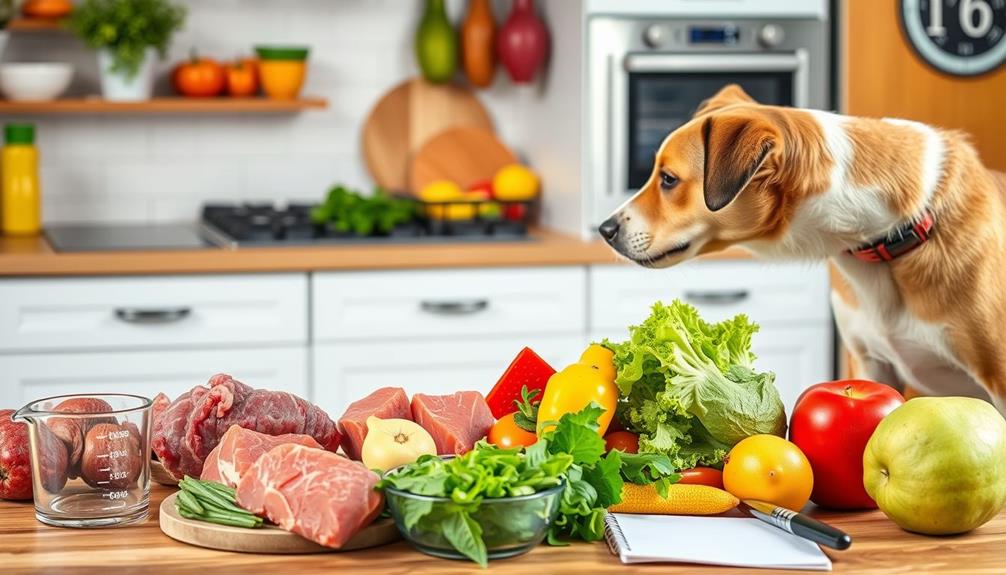
Shifting your dog to a raw diet can be an exciting journey, but it's important to approach it carefully. Start by gradually introducing nutritious raw food to minimize potential digestive issues. Begin with small amounts and observe your dog's reaction. It's vital to consult with a veterinarian during this change phase to confirm it's safe and tailored to your dog's needs.
While changing to a raw diet, you might notice some weight loss initially. This can be due to the loss of water weight, but it shouldn't exceed 1-2% of your dog's body weight per week. Monitoring your dog's health is essential, so adjust the food intake as necessary.
Using prepackaged raw meals can simplify the process, providing convenience and balanced nutrition. To help you determine how much raw to feed, consider the following table:
| Step | Action | Notes |
|---|---|---|
| 1 | Start slow | Introduce small portions |
| 2 | Monitor reactions | Look for any digestive issues |
| 3 | Adjust as needed | Consult your vet for guidance |
Following these steps will help guarantee a smooth change to a raw diet for your dog.
Using a Raw Food Calculator
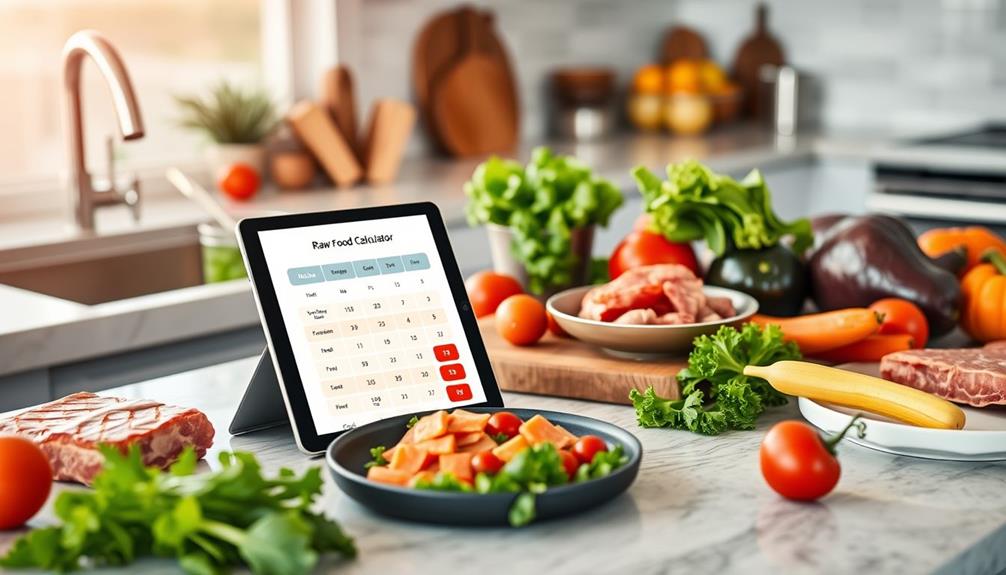
Here's how to effectively use the calculator:
1. Choose the percentage: Decide how much of your dog's diet should consist of raw food. You can select anywhere from 10% to 100%, depending on their requirements.
It's important to take into account how critical periods of development can affect your dog's nutritional needs at various life stages.
2. Evaluate individual factors: Adjustments may be necessary based on your dog's activity level, age, and any health conditions. For instance, younger dogs might require more calories to support their growth compared to older, less active dogs.
3. Monitor regularly: Keep a close eye on your dog's health and weight. The calculator serves as a guideline, not a strict rule.
Utilizing this raw food calculator can help guarantee your dog receives the right nutrient intake while maintaining a healthy weight.
Selecting Nutritious Raw Brands
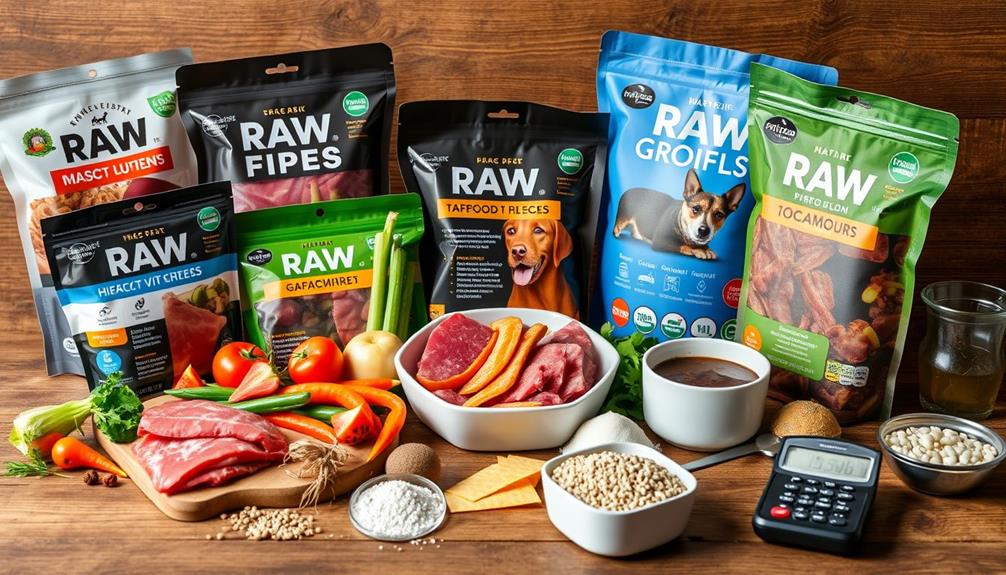
When selecting raw dog food brands, focus on ingredient quality and brand reputation.
Look for companies that prioritize hormone-free and antibiotic-free ingredients, as this guarantees your dog gets the best nutrition possible.
A brand's transparency about its sourcing and preparation can also help you make an informed decision.
Ingredient Quality Assurance
Choosing the right raw dog food brand is vital for your pet's health, and it starts with ingredient quality. When selecting a nutritious raw food brand, make certain that the meals are hormone-free, antibiotic-free, and free from additives and preservatives. This guarantees peak health and a balanced diet for your furry friend.
Here are three key factors to take into account for ingredient quality assurance:
- Reputable Sourcing: Look for brands that provide transparent ingredient lists and source their ingredients responsibly. This directly impacts the nutritional value of the food your dog consumes.
- Complete Nutrient Profile: Opt for brands like We Feed Raw, which offer balanced meals that include muscle meat, organ meat, and finely ground bone. This makes certain a thorough nutrient profile without fillers.
- Quality Control Measures: Investigate the brand's quality control protocols. Consistent safety and nutritional content are fundamental for your dog's health.
Investing in high-quality raw food can lead to better overall health outcomes for your dog, making it worth the cost.
Prioritize ingredient quality to make certain your pet thrives on a nutritious raw diet.
Brand Reputation Importance
In the world of raw dog food, a brand's reputation serves as a critical indicator of its trustworthiness and commitment to quality. When you're selecting a nutritious raw brand, it's important to look for those with a strong track record. Brands like We Feed Raw exemplify this by offering complete and balanced meals tailored for all life stages, incorporating muscle meat, organ meat, and finely ground bone without fillers or preservatives.
A reputable brand prioritizes ingredient quality and implements stringent quality control measures to guarantee safety and consistency. This not only helps maintain the nutritional value of the food but also gives you peace of mind about what you're feeding your dog.
Additionally, a solid brand reputation often reflects a commitment to ethical practices, such as sourcing hormone-free and antibiotic-free ingredients.
Don't underestimate the power of customer reviews and testimonials; they can offer valuable insights into a brand's reliability and the effectiveness of its products in promoting pet health. By choosing a brand with a stellar reputation, you're investing in your dog's wellbeing and guaranteeing they receive the best nutrition possible.
Frequently Asked Questions
How Much Raw Food Should I Feed My Dog Chart?
Check a raw food feeding chart to determine the right amount for your dog. Generally, adult dogs need 2-3% of their ideal body weight, while puppies require 5-10%. Adjust based on activity and health.
What Is the 80 10 10 Rule for Raw Dog Food?
Picture a wild wolf feasting under the moonlight. The 80/10/10 rule for raw dog food means you're feeding your pup 80% muscle meat, 10% organ meat, and 10% bone for balanced nutrition and energy.
What Is the Best Raw Food Ratio for Dogs?
To find the best raw food ratio for your dog, consider their weight, age, and activity level. Generally, aim for 2-3% of their body weight daily, adjusting for smaller or growing dogs as needed.
How Do I Calculate How Much Food to Feed My Dog?
To calculate how much food to feed your dog, multiply their weight in pounds by 2% to 3%. Adjust based on their activity level and health needs for the best results.
Conclusion
So, you thought feeding your dog raw food would be as simple as tossing them a steak, huh? Turns out, it's a bit more complicated! But with the right calculations and quality ingredients, you can give your pup a diet that'll make them the envy of the dog park. Just remember, the more you know, the more you realize you don't know—so keep learning, and your dog will thank you with wagging tails and happy barks!

